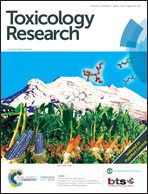Fresh and ozonized black carbon promoted DNA damage and repair responses in A549 cells
Abstract
Nano-sized ambient black carbon (BC) is hypothesized to pose a serious threat to human health. After emission into the air, the atmospheric oxidation process can modify its physiochemical properties and change its biological responses. In this study, we aimed to compare different DNA damage and repair responses promoted by fresh BC (FBC) and ozone oxidized-BC (OBC). The cell apoptosis, cell arrest, DNA damage and repair were investigated in A549 cells after treatment with FBC and OBC. Associated gene expressions were measured with the reverse transcription quantitative polymerase chain reaction (RT-qPCR) method. Both FBC and OBC could induce cell apoptosis in A549 cells with up-regulated gene of promyelocytic leukemia protein (pml) and down-regulated gene of anti-apoptotic B-cell lymphoma-2 (bcl-2). FBC caused cell cycle arrest at S and G2/M phases, which was associated with up-regulated ataxia telangiectasia mutated (atm), checkpoint kinase 2 (chk2), structural maintenance of chromosomes 1 (smc1) and cell division cycle 25 homolog A (cdc25a) genes. OBC promoted cell cycle arrest at the S phase with up-regulated genes of atm, chk2 and smc1. Both FBC and OBC induced oxidative DNA damage and time-dependent DNA repair responses with increased gene expressions of breast cancer susceptibility protein 1 (brca1), recombination protein A paralog B (rad51b), methyl methanesulfonate-sensitivity protein 22-like and tonsoku-like (mms22l). Compared to FBC, OBC could cause more sufficient DNA damage repair responses through cell cycle arrest at the S phase, resulting in relatively weaker DNA damages.



 Please wait while we load your content...
Please wait while we load your content...